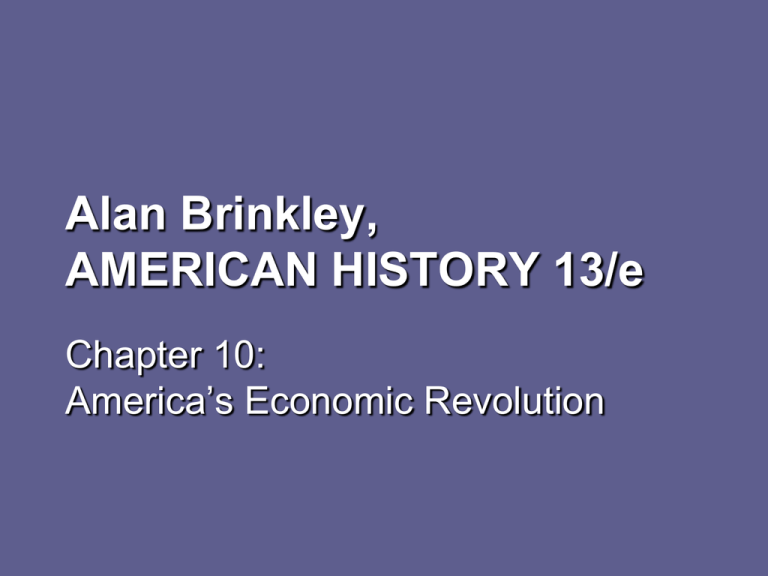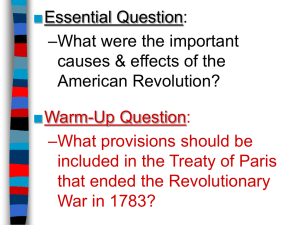
Alan Brinkley,
AMERICAN HISTORY 13/e
Chapter 10:
America’s Economic Revolution
Chapter Ten:
America’s Economic Revolution
Introduction
The Market Revolution
Regional Divergences
The Changing American Population
– The American Population, 1820-1840
Reasons for Population Increase
2
© 2010, The McGraw-Hill Companies, Inc. All Rights Reserved.
Chapter Ten:
America’s Economic Revolution
Population Growth 1620-1860
3
Immigration 1820-1840
© 2010, The McGraw-Hill Companies, Inc. All Rights Reserved.
Chapter Ten:
America’s Economic Revolution
American Population Density, 1820
4
© 2010, The McGraw-Hill Companies, Inc. All Rights Reserved.
Chapter Ten:
America’s Economic Revolution
American Population Density, 1860
5
© 2010, The McGraw-Hill Companies, Inc. All Rights Reserved.
Chapter Ten:
America’s Economic Revolution
The Changing American Population
– Immigration and Urban Growth, 1840-1860
Rapid Urbanization
Surging Immigration
German and Irish Immigrants
6
© 2010, The McGraw-Hill Companies, Inc. All Rights Reserved.
Chapter Ten:
America’s Economic Revolution
Sources of Immigration, 1820-1840
7
Sources of Immigration, 1840-1860
© 2010, The McGraw-Hill Companies, Inc. All Rights Reserved.
Chapter Ten:
America’s Economic Revolution
The Changing American Population
– The Rise of Nativism
Native American Party
The Know-Nothings
8
© 2010, The McGraw-Hill Companies, Inc. All Rights Reserved.
Chapter Ten:
America’s Economic Revolution
Transportations, Communications, and
Technology
– The Canal Age
Steamboats
Economic Advantages of Canals
The Erie Canal
9
© 2010, The McGraw-Hill Companies, Inc. All Rights Reserved.
Chapter Ten:
America’s Economic Revolution
Canals in the NE, 1823-1860
10
© 2010, The McGraw-Hill Companies, Inc. All Rights Reserved.
Chapter Ten:
America’s Economic Revolution
Transportations, Communications, and
Technology
– The Early Railroads
Technological Basis
of the Railroad
Competition between
Railroads and Canals
The Dewitt Clinton, 1831
(Library of Congress)
11
© 2010, The McGraw-Hill Companies, Inc. All Rights Reserved.
Chapter Ten:
America’s Economic Revolution
Transportations, Communications, and
Technology
– The Triumph of the Rails
Consolidation
12
© 2010, The McGraw-Hill Companies, Inc. All Rights Reserved.
Chapter Ten:
America’s Economic Revolution
Railroad Growth, 1850-1860
13
© 2010, The McGraw-Hill Companies, Inc. All Rights Reserved.
Chapter Ten:
America’s Economic Revolution
Transportations, Communications, and
Technology
– Innovations in Communications
and Journalism
The Telegraph
The Associated Press
Fueling Sectional Discord
Samuel Morse
(Portrait Gallery)
14
© 2010, The McGraw-Hill Companies, Inc. All Rights Reserved.
Chapter Ten:
America’s Economic Revolution
Commerce and Industry
Impact of the Market Economy
– The Expansion of Business, 1820-1840
Advantages of the Corporation
Inadequate Credit
15
© 2010, The McGraw-Hill Companies, Inc. All Rights Reserved.
Chapter Ten:
America’s Economic Revolution
Commerce and Industry
– The Emergence of the Factory
Transformation of the Shoe Industry
The Industrial Northeast
– Advances in Technology
Interchangeable Parts
Technological Innovations
– Innovations in Corporate Organization
Decline of Merchant Capitalism
16
© 2010, The McGraw-Hill Companies, Inc. All Rights Reserved.
Chapter Ten:
America’s Economic Revolution
Men and Women at Work
– Recruiting a Native Work Force
Transformation of American Agriculture
The Lowell System
Women Workers
Decline of the Lowell System
17
© 2010, The McGraw-Hill Companies, Inc. All Rights Reserved.
Chapter Ten:
America’s Economic Revolution
Lowell, Massachusetts, 1832
18
© 2010, The McGraw-Hill Companies, Inc. All Rights Reserved.
Chapter Ten:
America’s Economic Revolution
Men and Women at Work
– The Immigrant Workforce
Economic Advantages of Immigrant Labor
Harsh Work Conditions
– The Factory System and the Artisan Tradition
De-skilling
National Trade Unions
19
© 2010, The McGraw-Hill Companies, Inc. All Rights Reserved.
Chapter Ten:
America’s Economic Revolution
Men and Women at Work
– Fighting for Control
Commonwealth v. Hunt
Female Protective Unions
America’s Divided Working Class
20
© 2010, The McGraw-Hill Companies, Inc. All Rights Reserved.
Chapter Ten:
America’s Economic Revolution
Patterns of Industrial Society
– The Rich and the Poor
Increasing Inequality in Wealth
The Urban Poor
African-American Poverty
– Social Mobility
Social Mobility
21
© 2010, The McGraw-Hill Companies, Inc. All Rights Reserved.
Chapter Ten:
America’s Economic Revolution
Patterns of Industrial Society
– Middle-Class Life
Rapidly Expanding Middle Class
New Household Inventions
Growing Class Distinctions
– The Changing Family
Declining Economic Role of the Family
Falling Birth Rates
22
© 2010, The McGraw-Hill Companies, Inc. All Rights Reserved.
Chapter Ten:
America’s Economic Revolution
Patterns of Industrial Society
– Women and the “Cult of Domesticity”
Female Education
New Roles for Women
Women’s Separate Sphere
Benefits and Costs
Working Class Women
23
© 2010, The McGraw-Hill Companies, Inc. All Rights Reserved.
Chapter Ten:
America’s Economic Revolution
Patterns of Industrial Society
– Leisure Activities
Minstrel Shows
P.T. Barnum
24
© 2010, The McGraw-Hill Companies, Inc. All Rights Reserved.
Chapter Ten:
America’s Economic Revolution
The Agricultural North
Rise of Commercial
Agriculture
– Northeastern Agriculture
Truck Farming
in the Northeast
New England, 1823
(Royalty-Free/CORBIS)
25
© 2010, The McGraw-Hill Companies, Inc. All Rights Reserved.
Chapter Ten:
America’s Economic Revolution
The Agricultural North
– The Old Northwest
Industrialization in the Old Northwest
Agricultural Specialization
Growing Ties between Northeast and Northwest
New Agricultural Techniques
McCormick Reaper
– Rural Life
Importance of Religion in Rural Communities
26
© 2010, The McGraw-Hill Companies, Inc. All Rights Reserved.
Chapter Ten:
America’s Economic Revolution
Patterns of Popular Culture:
Shakespeare
in America
The Booths in Julius Caesar
(Library of Congress)
27
© 2010, The McGraw-Hill Companies, Inc. All Rights Reserved.








